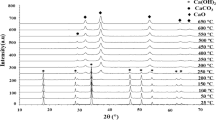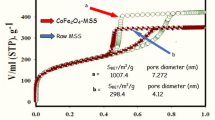Abstract
Fluoride contamination in groundwater may pose serious health issues. Among all the technologies, adsorption is considered to be highly efficient and is widely used for remediation in environment. In the present study, copper oxide nanoparticles (CuO) were synthesized by chemical precipitation method and used as adsorbent. The study intends to examine copper oxide nanoparticles behaviour when fluoride ions are present in an aqueous solution. The batch mode experiment demonstrated a substantial ability of the copper oxide nanoparticles for adsorption of fluoride with an adsorption capacity of 69.9 mg/g at a pH of 6, temp 298 K and adsorbent dose of 0.5 g/L.









Similar content being viewed by others
References
Jaishankar M, Tseten T, Anbalagan N, Mathew B, Beeregowda K (2014) Toxicity, mechanism and health effects of some heavy metals. Interdiscip Toxicol 7:60–72. https://doi.org/10.2478/intox-2014-0009
Yadav KK, Kumar S, Pham QB, Gupta N, Rezania S, Kamyab H, Yadav S, Vymazal J, Kumar V, Tri DQ, Talaiekhozani A, Prasad S, Reece LM, Singh N, Maurya PK, Cho J (2019) Fluoride contamination, health problems and remediation methods in Asian groundwater: a comprehensive review. Ecotoxicol Environ Saf 182:109362. https://doi.org/10.1016/j.ecoenv.2019.06.045
Savisto N, Grönroos TJ, Oikonen V, Rajander J, Loyttyniemi E, Bergman J, Forsback S, Solin O, Solin M (2023) [18 F] Fluoride uptake in various bone types and soft tissues in rat. EJNMMI Res. https://doi.org/10.1186/s13550-023-00969-4
ASTDR (2003) Toxicological profile for fluorides , hydrogen fluoride , and fluorine. Agency for Toxic Substances and Disease Registry
Mohammadi AA, Yousefi M, Yaseri M, Jalilzadeh M, Mahvi AH (2017) Skeletal fluorosis in relation to drinking water in rural areas of West. Sci Rep. https://doi.org/10.1038/s41598-017-17328-8
Cao J, Chen Y, Chen J, Yan H, Li M, Wang J (2016) Chemosphere Fluoride exposure changed the structure and the expressions of Y chromosome related genes in testes of mice. Chemosphere 161:292–299. https://doi.org/10.1016/j.chemosphere.2016.06.106
Yang C, Cheng M, Tsai S, Hung C (2000) Fluoride in drinking water and cancer mortality in Taiwan. Environ Res 193:189–193. https://doi.org/10.1006/enrs.1999.4018
Tiwari KK, Krishan G, Prasad G, Mondal NC, Bhardwaj V (2020) Groundwater for sustainable development evaluation of fluoride contamination in groundwater in a semi-arid region, Dausa District, Rajasthan, India. Groundw Sustain Dev 11:100465. https://doi.org/10.1016/j.gsd.2020.100465
Jarvis HG, Heslop P, Kisima J, Gray WK, Ndossi G, Maguire A, Walker RW (2013) Prevalence and aetiology of juvenile skeletal fluorosis in the south-west of the Hai district, Tanzania–a community-based prevalence and case–control study. Trop Med Int Health 18:222–229. https://doi.org/10.1111/tmi.12027
Demelash H, Beyene A, Abebe Z, Melese A (2019) Fluoride concentration in ground water and prevalence of dental fluorosis in Ethiopian Rift Valley: systematic review and meta-analysis. BMC Public Health. https://doi.org/10.1186/s12889-019-7646-8
WHO (2022) Guidelines for drinking-water quality: fourth edition incorporating the first and second addenda. World Health Organization, Geneva
Rehman F, Siddique J, Shahab A, Azeem T, Bangash AA, Naseem AA, Riaz O, Rehman F, Rehman Q (2022) Environmental technology & innovation hydrochemical appraisal of fluoride contamination in groundwater and human health risk assessment at Isa Khel. Environ Technol Innov 27:102445. https://doi.org/10.1016/j.eti.2022.102445
Zhang Q, Xu P, Qian H, Yang F (2020) Hydrogeochemistry and fluoride contamination in Jiaokou Irrigation District, Central China: Assessment based on multivariate statistical approach and human health risk. Sci Total Environ. 741:140460. https://doi.org/10.1016/j.scitotenv.2020.140460
Mwiathi NF, Gao X, Li C, Rashid A (2022) Ecotoxicology and Environmental Safety The occurrence of geogenic fluoride in shallow aquifers of Kenya Rift Valley and its implications in groundwater management. Ecotoxicol Environ Saf 229:113046. https://doi.org/10.1016/j.ecoenv.2021.113046
Podgorski JE, Labhasetwar P, Saha D, Berg M (2018) Prediction modeling and map** of groundwater fluoride contamination throughout India. Environ Sci Technol. https://doi.org/10.1021/acs.est.8b01679
Ishii T, Suckling G (2015) The severity of dental fluorosis in children exposed to water with a high fluoride content for various periods of time. 1–2
Bhatnagar A, Kumar E, Sillanpää M (2011) Fluoride removal from water by adsorption-A review. Chem Eng J 171:811–840. https://doi.org/10.1016/j.cej.2011.05.028
Lin J, Wu Y, Khayambashi A, Wang X (2018) Preparation of a novel CeO2/SiO2 adsorbent and its adsorption behavior for fluoride ion. Adsorpt Sci Technol 36:743–761. https://doi.org/10.1177/0263617417721588
Amenaghawon AN, Anyalewechi CL, Darmokoesoemo H, Kusuma HS (2022) Hydroxyapatite-based adsorbents: applications in sequestering heavy metals and dyes. J Environ Manage 302:113989. https://doi.org/10.1016/j.jenvman.2021.113989
Sathish RS, Raju NSR, Raju GS, Rao GN, Kumar KA, Janardhana C (2007) Equilibrium and kinetic studies for fluoride adsorption from water on zirconium impregnated coconut shell carbon. Sep Sci Technol 42:769–788. https://doi.org/10.1080/01496390601070067
Sahraei R, Sekhavat Pour Z, Ghaemy M (2017) Novel magnetic bio-sorbent hydrogel beads based on modified gum tragacanth/graphene oxide: Removal of heavy metals and dyes from water. J Clean Prod 142:2973–2984. https://doi.org/10.1016/j.jclepro.2016.10.170
El-Trass A, Elshamy H, El-Mehasseb I, El-Kemary M (2012) CuO nanoparticles: synthesis, characterization, optical properties and interaction with amino acids. Appl Surf Sci 258:2997–3001. https://doi.org/10.1016/j.apsusc.2011.11.025
Singh G, Virpal SRC (2019) Highly sensitive gas sensor based on Er-doped SnO2 nanostructures and its temperature dependent selectivity towards hydrogen and ethanol. Sens Actuators B Chem 282:373–383. https://doi.org/10.1016/j.snb.2018.11.086
Clesceri LS, Greenberg AE, Eaton AD (1999) Anionic surfactants as MBAS. Stand methods exam water wastewater 1027–1033
Alagumuthu G, Veeraputhiran V, Venkataraman R (2010) Adsorption isotherms on fluoride removal: batch techniques. Arch Appl Sci Res 2:170–185
Tazikeh S, Akbari A, Talebi A, Talebi E (2014) Synthesis and characterization of tin oxide nanoparticles via the Co-precipitation method. Mater Sci Pol 32:98–101. https://doi.org/10.2478/s13536-013-0164-y
Blanco-Flores A, Arteaga-Larios N, Pérez-García V, Gutierrez GM, Escamilla MO, Torres IR (2018) Efficient fluoride removal using Al-Cu oxide nanoparticles supported on steel slag industrial waste solid. Environ Sci Pollut Res 25:6414–6428. https://doi.org/10.1007/s11356-017-0849-6
Raul PK, Devi RR, Umlong IM, Banerjee S, Singh L, Purkait M (2012) Removal of fluoride from water using iron oxide-hydroxide nanoparticles. J Nanosci Nanotechnol 12:3922–3930. https://doi.org/10.1166/jnn.2012.5870
Waghmare S, Arfin T, Rayalu S, Lataye D, Dubey S, Tiwari S (2015) Adsorption behavior of modified zeolite as novel adsorbents for fluoride removal from drinking water: surface phenomena, kinetics and thermodynamics studies. Int J Sci Eng Technol Res 4:4114–4124
Yapo NS, Aw S, Briton BGH, Drogui P, Yao KB, Adouby K (2022) Removal of fluoride in groundwater by adsorption using hydroxyapatite modified Corbula trigona shell powder. Chem Eng J Adv. https://doi.org/10.1016/j.ceja.2022.100386
Errais E, Duplay J, Darragi F, M’Rabet I, AubertbA HF, Morvan G (2011) Efficient anionic dye adsorption on natural untreated clay: kinetic study and thermodynamic parameters. Desalination 275:74–81. https://doi.org/10.1016/j.desal.2011.02.031
Acknowledgements
Authors are delighted to acknowledge the Department of Emerging Science of Guru Nanak Dev University for providing the facility of instruments to carry out the present study.
Author information
Authors and Affiliations
Corresponding author
Ethics declarations
Conflict of interest
Authors have no conflict of interest with anyone.
Additional information
Publisher's Note
Springer Nature remains neutral with regard to jurisdictional claims in published maps and institutional affiliations.
Rights and permissions
Springer Nature or its licensor (e.g. a society or other partner) holds exclusive rights to this article under a publishing agreement with the author(s) or other rightsholder(s); author self-archiving of the accepted manuscript version of this article is solely governed by the terms of such publishing agreement and applicable law.
About this article
Cite this article
Thakur, A., Sharma, N. & Singh, J. Synthesis of copper oxide (CuO) nanoparticles for the efficient removal of fluoride from an aqueous solution. J Radioanal Nucl Chem 333, 2857–2865 (2024). https://doi.org/10.1007/s10967-023-09066-1
Received:
Accepted:
Published:
Issue Date:
DOI: https://doi.org/10.1007/s10967-023-09066-1




